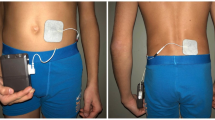Abstract
Purpose
Anismus is a significant cause of chronic constipation. This study came to revive the results of BFB training and BTX-A injection in the treatment of anismus patients.
Materials and methods
Forty-eight patients with anismus (33 women; mean age 39.6 ± 15.9) were included in this study. All patients fulfilled Rome II criteria for functional constipation. All patients underwent anorectal manometry, balloon expulsion test, defecography, and electromyography (EMG) activity of the EAS. All patients had non-relaxing puborectalis muscle. The patients were randomized into two groups. Group I patients received biofeedback therapy, two times per week for about 1 month. Group II patients were injected with BTX-A. Follow-up was conducted weekly in the first month then monthly for about 1 year.
Results
In the BFB training group, three patients quit before the end of sessions with no improvement; initial improvement was recorded in 12 patients (50%) while long-term success was recorded in six patients (25%). In the BTX-A group, clinical improvement was recorded in 17 patients (70.83%), but the improvement persisted only in eight patients (33.3%). There is a significant difference between BTX-A group and BFB group regarding the initial success, but this significant difference disappeared at the end of follow-up. Manometric relaxation was achieved significantly post-BFB and post-BTX-A injection with no significant difference between the two groups.
Conclusions
Biofeedback training has a limited therapeutic effect on patients suffering from anismus. BTX-A injection seems to be successful for temporary treatment of anismus.
Similar content being viewed by others
References
Preston DM, Lennard-Jones JE (1985) Anismus in chronic constipation. Dig Dis Sci 30:413–418
Kuijpers HC, Bleijenberg G (1985) The spastic pelvic floor syndrome, a cause of constipation. Dis Colon Rectum 28:669–672
Miller R, Duthie GS, Bartolo DC, Roe AM, Locke-Edmunds J, Mortensen NJ (1991) Anismus in patients with normal and slow transit constipation. Br J Surg 78:690–692
Bleijenberg G, Kuijpers HC (1987) Treatment of the spastic pelvic floor syndrome with biofeedback. Dis Colon Rectum 30:108–115
Kawimbe BM, Papachrysostomou M, Binnie NR, Clare N, Smith AN (1991) Outlet obstruction constipation (anismus) managed by biofeedback. Gut 32:1175–1179
Siproudhis L, Dautreme S, Robert A et al (1995) Anismus and biofeedback: who benefits? Eur J Gastroenterol Hepatol 7:547–552
Park UC, Choi SK, Piccirillo MF, Verzaro R, Wexner SD (1996) Patterns of anismus and the relation to biofeedback therapy. Dis Colon Rectum 39:768–773
Hallan RI, Williams NS, Melling J, Waldron DJ, Womack NR, Morrison JF (1988) Treatment of anismns in intractable constipation with botulinum toxin. Lancet 2:714–717
Jankovic J, Brin MF (1991) Therapeutic uses of botulinum toxins. N Engl Med 1 324:1186–1194
Joo JS, Agachan F, Wolff B, Nogueras JJ, Wexner SD (1996) Initial North American experience with botulinum toxin Type A for treatment of anismus. Dis Colon Rectum 39:1107–1111
Maria G, Brisinda G, Bentivoglio AR, Cassetta E, Albanese A (2000) Botulinum toxin in the treatment of outlet obstruction constipation caused by puborectalis syndrome. Dis Colon Rectum 43:376–380
Ron Y, Avni Y, Lukovetski A, Wardi J, Geva D, Birkenfeld S, Halpern Z (2001) Botulinum toxin type-A in therapy of patients with anismus. Dis Colon Rectum 44:1821–1826
Thompson WG, Longstreth GF, Drossman DA, Heaton KW, Irvine EJ, Muller-Lissner SA (1999) Functional bowel disorders and functional abdominal pain. Gut 45(Suppl 2):II43–II44
Halligan S, Bartram C, Park HJ, Kamm M (1995) Proctographic features of anismus. Radiology 197:679–682
McGee SG, Bartram CI (1993) Intra-anal intussusception: diagnosis by posteroanterior stress proctography. Abdom Image 18:136–140
Pemberton JH, Rath DM, Ilstrup M (1991) Evaluation and surgical treatment of sever chronic constipation. Ann Surg 214:403–413
Loening-Baucke V (1990) Modulation of abnormal dynamics by biofeedback treatment in chronically constipated children with encopresis. J Pediatr 116:214–222
Duthie GS, Bartolo DCC (1992) Anismus: The cause of constipation? Results of investigation and treatment. World J Surg 16:831–835
Barnes PRH, Hawley PR, Preston DM, Lennard Jones JE (1985) Experience of posterior division of the puborectalis muscles in managements of chronic constipation. Br J Surg 72:475–478
Glia A, Gylin M, Gullberg K, Lindberg G (1997) Biofeedback retraining in patients with functional constipation and paradoxical puborectalis contraction: comparison of anal manometry and sphincter electromyography for feedback. Dis Colon Rectum 40:889–895
Gilliland R, Heymen S, Altomare DF, Park UC, Vickers D, Wexner SD (1997) Outcome and predictors of success of biofeedback for constipation. Br J Surg 84:1123–1126
Meagher AP, Sun WM, Kennedy ML, Smart RC, Lubowski DZ (1999) Biofeedback for anismus: has placebo effect been overlooked? Colorectal Dis 1(2):80–87
Rhee PL, Choi MS, Kim YH, Son HJ, Kim JJ, Koh KC, Paik SW, Rhee JC, Choi KW (2000) An increased rectal maximum tolerable volume and long anal canal are associated with poor short-term response to biofeedback therapy for patients with anismus with decreased bowel frequency and normal colonic transit time. Dis Colon Rectum 43:1405–1411
McKee RF, McEnroe L, Anderson JH, Finlay IG (1999) Identification of patients likely to benefit from biofeedback for outlet obstruction constipation. Br J Surg 86:355–359
Shafik A, El Sibai O (1998) Botulinum toxin in the treatment of nonrelaxing puborectalis syndrome. Dig Surg 15:347–351
Author information
Authors and Affiliations
Corresponding author
Rights and permissions
About this article
Cite this article
Farid, M., El Monem, H.A., Omar, W. et al. Comparative study between biofeedback retraining and botulinum neurotoxin in the treatment of anismus patients. Int J Colorectal Dis 24, 115–120 (2009). https://doi.org/10.1007/s00384-008-0567-0
Accepted:
Published:
Issue Date:
DOI: https://doi.org/10.1007/s00384-008-0567-0




